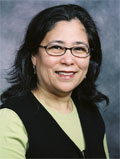Text Size:


Breast Cancer
By Dr. Carol Marquez
Breast cancer is a very common disease. Experts predict there will be about 180,000 new cases of breast cancer diagnosed in the United States this year alone. Breast cancer is the most common malignancy among women, with one in eight having the disease sometime during her lifetime.
Non-Modifiable Risk Factors
Two of the major risk factors for breast cancer can’t be controlled: Age and genetics. Incidences of breast cancer dramatically increase with age. Those who have a family history of breast cancer or who carry the gene for breast cancer are also at a higher risk.
Modifiable Risk Factors
Other risk factors can be influenced by lifestyle choices:
- Age at First Pregnancy
Women who have their first child after age 30 are at greater risk.
- Hormone Replacement Therapy
Women who take post-menopausal estrogen supplementation are at a greater risk.
- Childless
Women who don’t have children have a higher risk.
- Alcohol Intake
Having more than one drink a day puts a woman at higher risk.
- Body Mass
A higher body mass means a higher risk.
- Exercise
There is some evidence that regular exercise lowers risk.
Screening Tests
The most common, best studied, and most effective screening tool is still the mammogram. If there’s an abnormality found with the mammogram, then the patient will often have a follow-up ultrasound. But the ultrasound is used more for diagnosis than screening. MRI is used for high-risk populations only; it isn’t as effective as a general screening tool.
Signs and Symptoms
Usually, a woman will suspect possible breast cancer if she has felt a lump or has had a screening mammogram by which an abnormality has been found. Other, less common symptoms include pain, bloody nipple discharge, or redness of the skin. If you or your mom has had any of the above symptoms, see your doctor immediately.
Diagnosis
After a woman has discovered a lump or has had a mammogram that shows an abnormality, the next step for diagnosis is usually a biopsy. If the diagnosis is cancer, the doctor will discuss treatment options, which will depend on the type and stage of cancer.
- Non-invasive cancer
This is when the abnormal tumor cells are still contained within the ducts or the lobules of the breast, and haven’t invaded beyond the surrounding area of the duct into fat of the breast.
- Invasive cancer
This is when the tumor has spread into the fat of the breast, and there’s a risk the lymph nodes are involved, which means there’s also a risk the cancer has spread to other areas of the body.
Treatments
Breast cancer treatment is a great example of what we call multidisciplinary therapy, because whatever stage the patient is in, she needs to have, at the least, consultations with a team of doctors. This includes a surgeon, oftentimes a surgical oncologist that’s been specially trained in breast cancer, a medical oncologist who will discuss the need for chemotherapy or hormonal therapy, and a radiation oncologist who will talk about whether or not surgery is needed.
- Surgery is needed in nearly every breast cancer case. Surgical options include a lumpectomy, which is removing just the lump, to a mastectomy, which is removing the entire breast. The surgeon is also responsible for evaluating the lymph nodes, usually via a sentinel lymph node biopsy or by an auxiliary node dissection.
- Radiation
When a woman chooses to keep her breast, radiation is used to treat the breast to prevent a reoccurrence. Radiation is also used after a mastectomy if the patient has lymph nodes involved or other indications that she has a higher risk for reoccurrence – either where the breast was, or in the lymph nodes.
- Chemotherapy is used to treat early-stage invasive breast cancer to make sure it destroys any cancer cells surgery might have missed. It’s also used for more advanced stage breast cancer to destroy the cancer cells as much as possible. Sometimes chemo is used prior to surgery in order to shrink the tumor.
- Hormonal therapy medicines are used to treat hormone-receptor-positive breast cancer by lowering the amount of estrogen and preventing estrogen from acting on the cancer cells.
- Targeted cancer therapies include Herceptin, Tykerb, and Avastin, and are less likely to harm healthy cells while destroying the cancer cells.
If you or your mom has been diagnosed with breast cancer, know that this is a curable disease with many treatment options. Breast cancer research is an active, well-funded program with many improvements in therapy, especially in the last five years.

Dr. Carol Marquez is a radiation oncologist specializing in breast cancer at the Oregon Health & Science University Knight Cancer Institute. Her special interests include breast, pediatric and brain tumors. She has been board certified in radiation oncology since 1992. Dr. Marquez earned her medical degree and completed her residency at the University of California, San Francisco. She completed her fellowship at Stanford University in the Department of Radiation Oncology.
More...
Leave your comment
You must be an icarevillage member to comment on this article.
Join today
to take advantage of this service or
Sign In
if you are already a member.